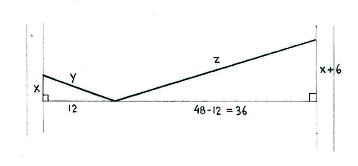Solution 4.1:10
From Förberedande kurs i matematik 1
First, let's decide to determine all distance in dm (decimeters), so that we have all the distances as integers.
Call the length of the washing line from the trees to the hanger y and z, as in the figure below, and introduce two auxiliary triangles which have y and z as their hypotenuses. (As an approximation, we suppose that the taut washing line consists of two straight parts.)

Because the line is 54 dm long, we have
| \displaystyle y+z=54\,\textrm{.} | (1) |
Then, the Pythagorean theorem gives the relations
| \displaystyle y^2 = x^2 + 12^2\,, | (2) |
| \displaystyle z^2 = (x+6)^2 + 36^2\,\textrm{.} | (3) |
The idea now is to solve the system of equations (1)-(3) by first eliminating z, so that we get two equations which only contain x and y. Then, eliminate y from one of these equations, so that we get an equation which determines x.
From (1), we have \displaystyle z = 54-y, and substituting this into (3) gives us the equation
| \displaystyle (54-y)^2 = (x+6)^2 + 36^2\,\textrm{.} | (3') |
Equations (2) and (3') together give a smaller system for x and y,
| \displaystyle \left\{ \begin{align}
& y^2 = x^2 + 12^2\,,\\[5pt] & (54-y)^2 = (x+6)^2 + 36^2\,\textrm{.} \end{align} \right. | \displaystyle \begin{align}(2)\\[5pt] (3')\end{align} |
Expand the quadratic terms on both sides of (3'),
| \displaystyle 54^2 - 2\cdot 54\cdot y + y^2 = x^2 + 2\cdot 6\cdot x + 6^2 + 36^2\,, |
and simplify
| \displaystyle 2916 - 108y + y^2 = x^2 + 12x + 1332\,\textrm{.} |
Use (2) and replace \displaystyle y^2 with \displaystyle x^2+12 in this equation,
| \displaystyle 2916 - 108y + x^2 + 144 = x^2 + 12x + 1332 |
which gets rid of the x²-term,
| \displaystyle 2916 - 108y + 144 = 12x + 1332\,, |
and further simplification gives the equation
| \displaystyle 12x + 108y = 1728 | (3") |
If we pause for a moment and summarize the situation, we see that we have succeeded in simplifying the equation system (2) and (3') to a system (2) and (3"), where one of the equations is linear
| \displaystyle \left\{ \begin{align}
& y^2 = x^2 + 12^2\,,\\[5pt] & 12x+108y=1728\,\textrm{.} \end{align} \right. | \displaystyle \begin{align}(2)\\[5pt] (3")\end{align} |
In this system, we can make y the subject in (3"),
| \displaystyle y=\frac{1728-12x}{108}=16-\frac{x}{9} |
and substitute into (2),
| \displaystyle \Bigl(16-\frac{x}{9}\Bigr)^2 = x^2 + 144\,\textrm{.} |
This is an equation which only contains x, and if we solve it, we will get our answer.
Expand the quadratic on the left-hand side,
| \displaystyle 16^{2}-2\cdot 16\cdot \frac{x}{9} + \Bigl(\frac{x}{9} \Bigr)^2 = x^2 + 144 |
and collect together all terms on one side,
| \displaystyle x^2 - \frac{x^{2}}{81} + \frac{32}{9}x + 144 - 16^{2} = 0\,, |
which gives the equation
| \displaystyle \frac{80}{81}x^2 + \frac{32}{9}x - 112 = 0\,\textrm{.} |
Multiply both sides by \displaystyle 81/80 so that we get the equation in standard form,
| \displaystyle x^{2} + \frac{18}{5}x - \frac{567}{5} = 0\,\textrm{.} |
Completing the square on the left-hand side gives
| \displaystyle \Bigl(x+\frac{9}{5}\Bigr)^2 - \Bigl(\frac{9}{5}\Bigr)^{2} - \frac{567}{5} = 0 |
and then
| \displaystyle \Bigl(x+\frac{9}{5}\Bigr)^2 = \frac{81}{25} + \frac{567}{5} = \frac{2916}{25}\,, |
i.e.
| \displaystyle x = -\frac{9}{5}\pm \sqrt{\frac{2916}{25}} = -\frac{9}{5}\pm \frac{54}{5}\,\textrm{.} |
This means that the equation has the solutions
| \displaystyle x=-\frac{9}{5}-\frac{54}{5}=-\frac{63}{5}\qquad\text{and}\qquad x=-\frac{9}{5}+\frac{54}{5}=9\,\textrm{.} |
The answer is thus \displaystyle x=9\ \textrm{dm} (the negative root must be discarded).
To be sure that we have calculated correctly, we also look at the values of y and z, and check that the original equations (1) to (3) are satisfied.
Equation (3") gives
| \displaystyle y = 16-\frac{x}{9} = 16-1 = 15 |
and equation (1) gives
| \displaystyle z=54-y=54-15=39\,\textrm{.} |
Now, we check that \displaystyle x=9, \displaystyle y=15 and \displaystyle z=39 satisfy the equations (1), (2) and (3),
| \displaystyle \begin{align}
\textrm{LHS of (1)} &= 15+39 = 54\,,\\[5pt] \textrm{RHS of (1)} &= 54\,,\\[10pt] \textrm{LHS of (2)} &= 15^2 = 225\,,\\[5pt] \textrm{RHS of (2)} &= 9^2 + 12^2 = 81+144 = 225\,,\\[10pt] \textrm{LHS of (3)} &= 39^2 = 1521\,,\\[5pt] \textrm{RHS of (3)} &= (9+6)^2 + 36^2 = 15^2 + 36^2 = 225+1296 = 1521\,\textrm{.} \end{align} |
